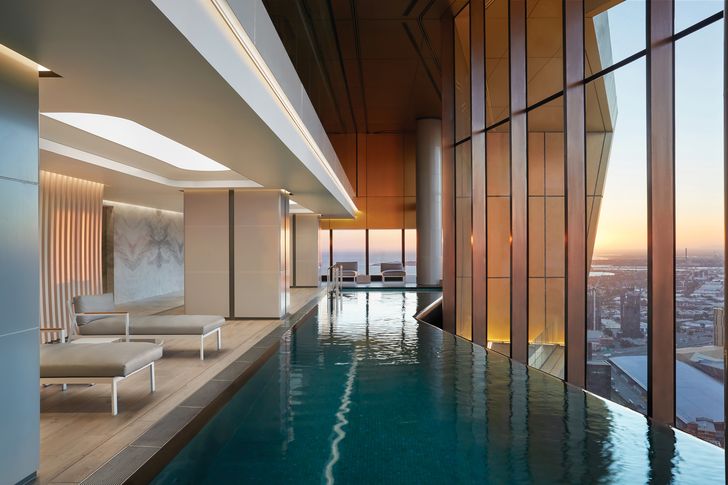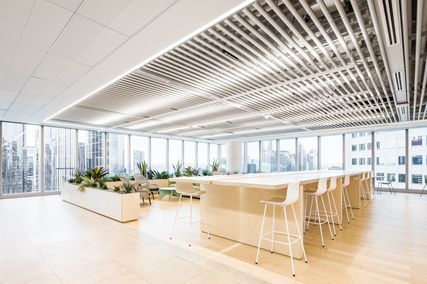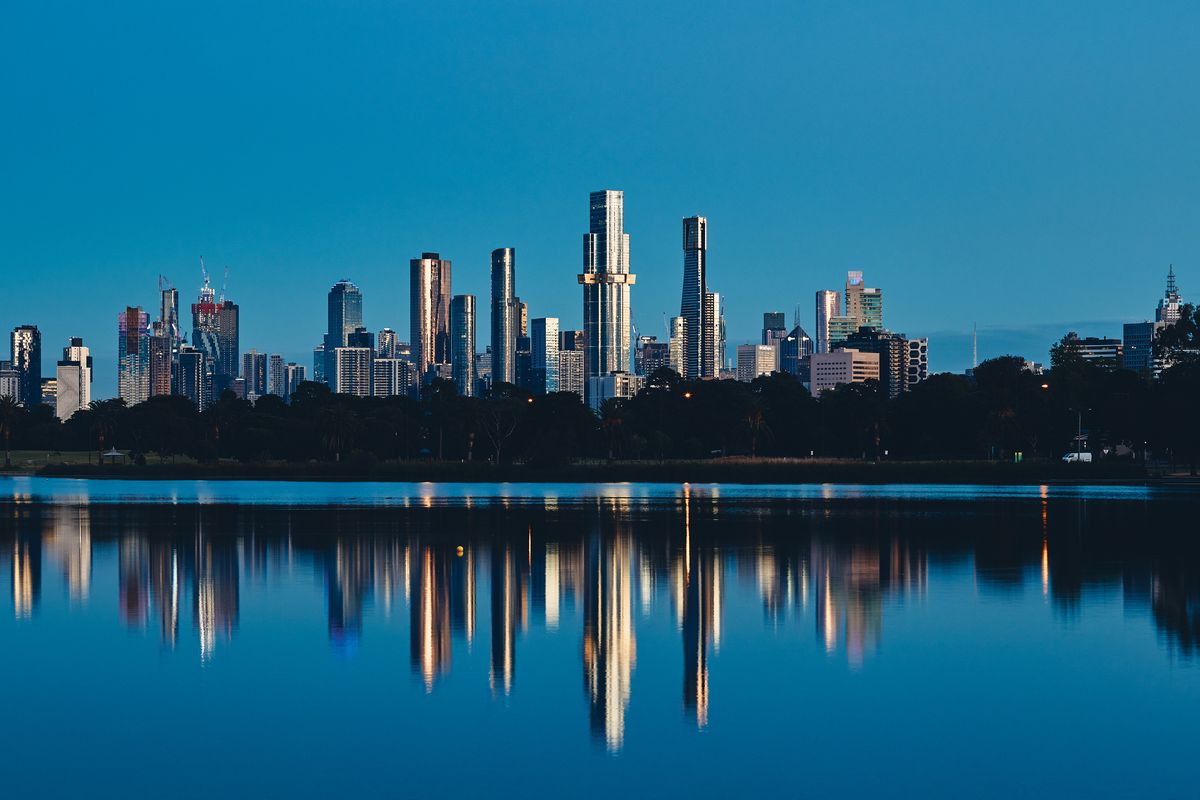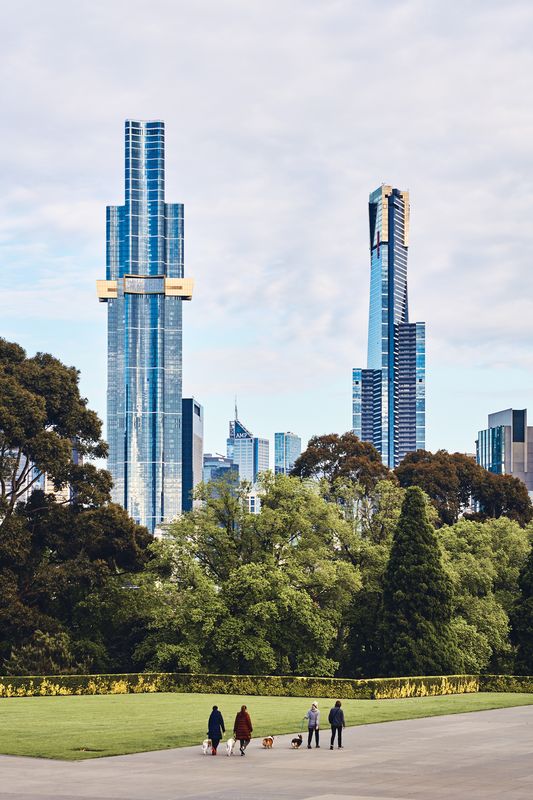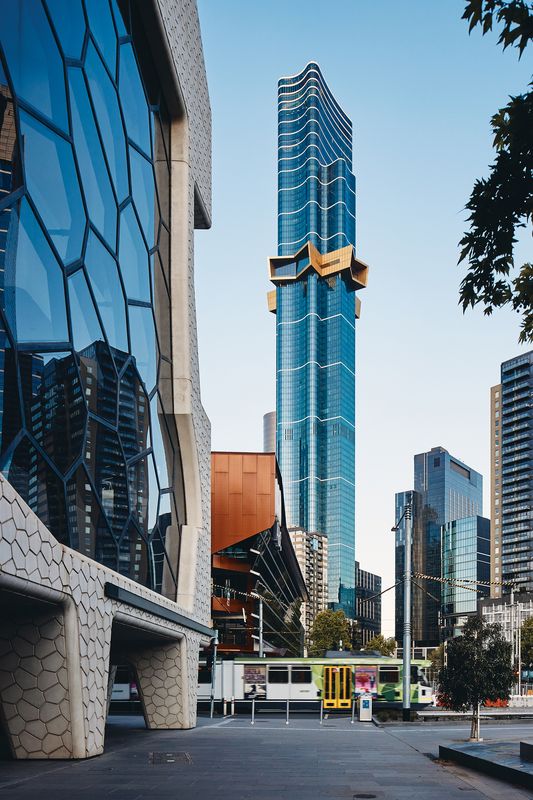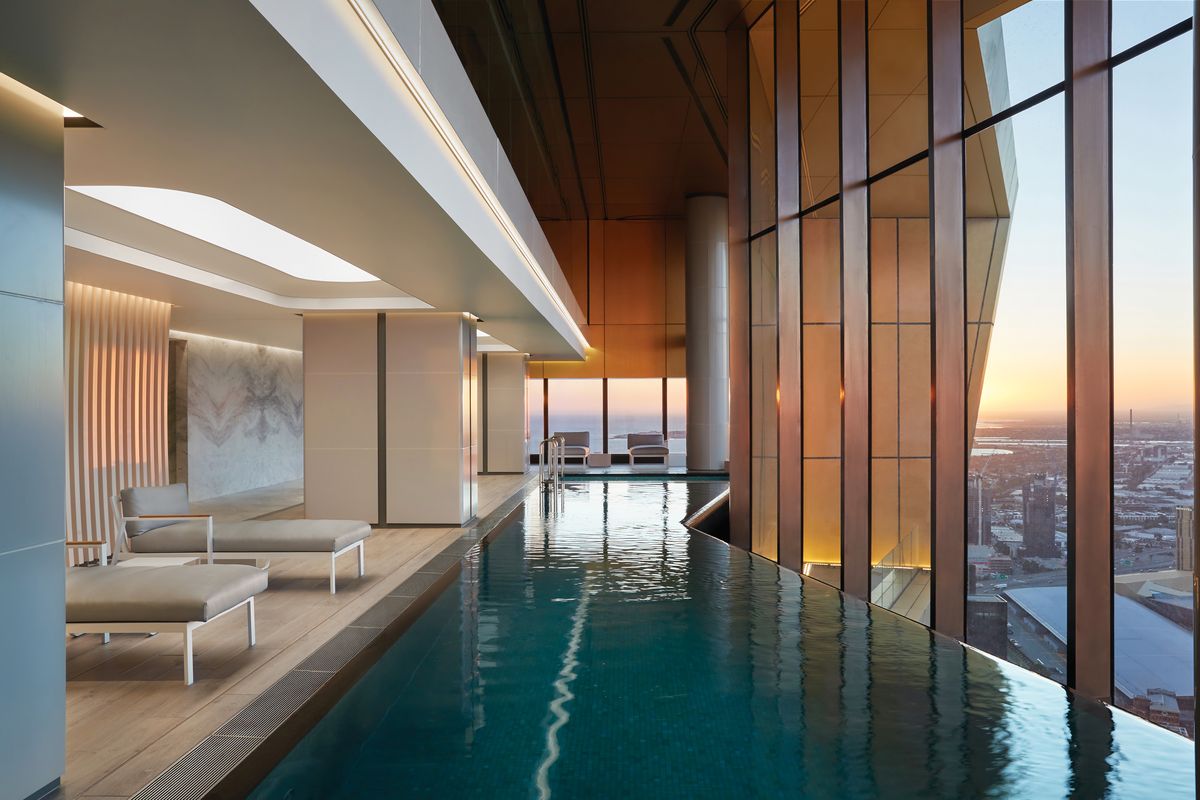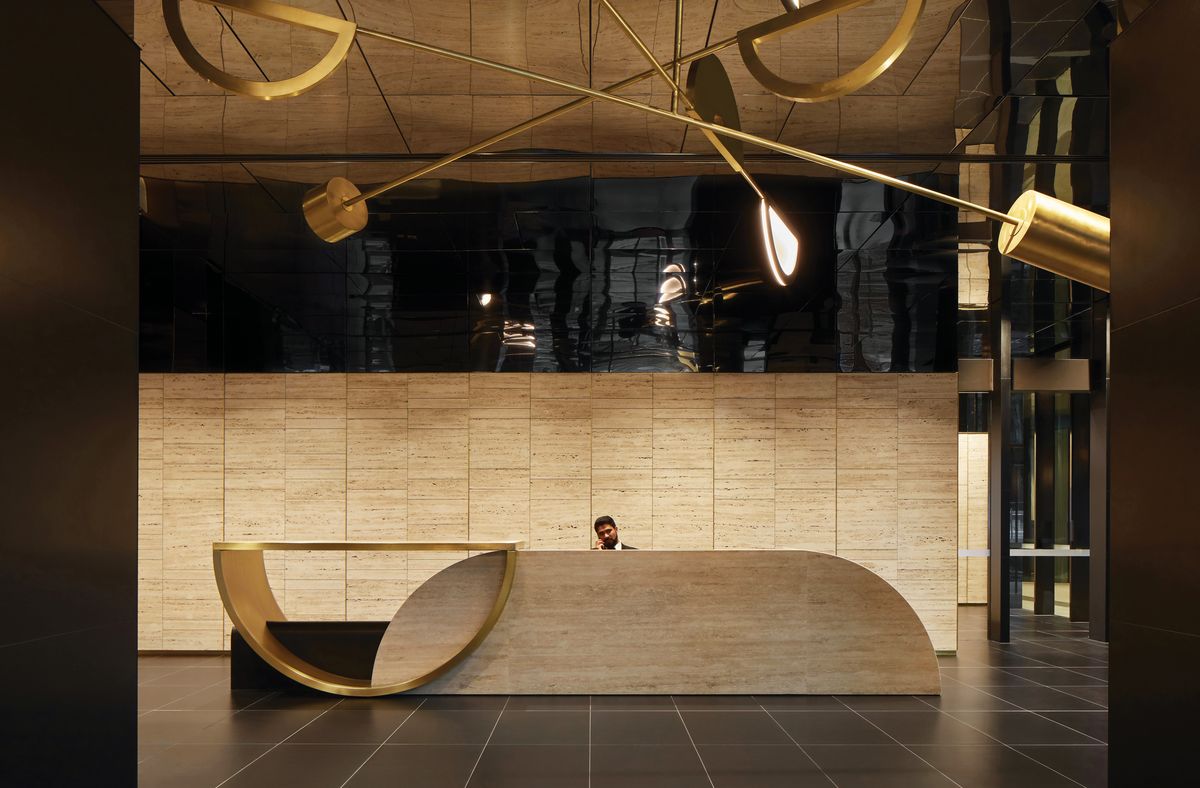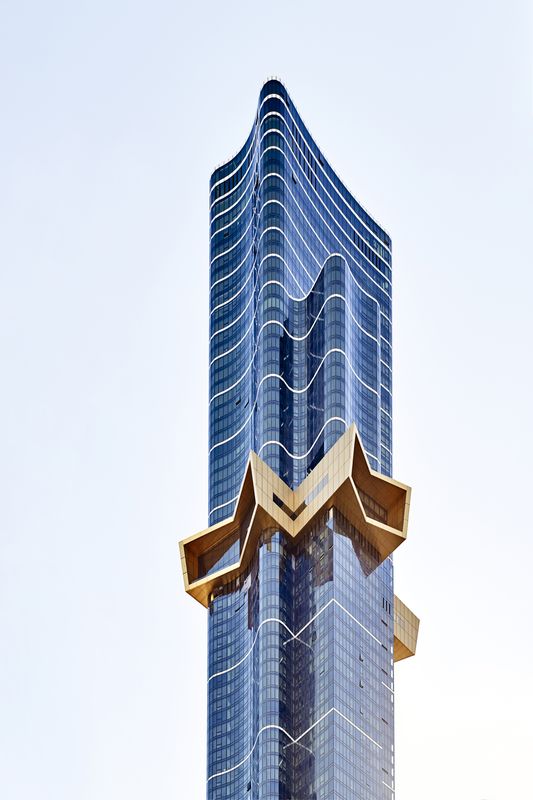Among the countless tall buildings erected worldwide, only a few capture the cultural spirit of a specific place and time in history. Occasionally, a single tower, or a group, represents an entire city or even a country at large – but only those that exceed ordinary expectations succeed in this symbolic role. Contrary to common misconceptions, vertical landmarks do not depend on height alone but more on expert professional skill, timeless formal intuition and rare technical prowess. The Flatiron was never the tallest building in New York but it was – and remains – one of its most iconic. Observing Melbourne’s skyline from the “starburst” – the cantilevered communal-space container of Australia 108, the new Fender Katsalidis-designed skyscraper in Southbank – one cannot escape to decide whether this tower, which is the tallest in Melbourne, for now – will become one of these vertical icons.
The Eureka Tower, the landmark residential skyscraper designed by the same architects in the early 2000s, now has a slightly taller and yet familiar companion in Australia 108. The latest addition to Southbank’s growing skyline is another sky-reflecting tower, but with an unusual, golden-starred volume that bursts out of the building envelope midway up. After their thoughts on public iconicity settle, many Melburnians may also wonder: How can I get up there? Short-term stay or friendship with a resident will be the only answer, for most.
Australia 108 is one of many off-limits residential towers fueled by investments from China, Malaysia and Singapore that have crowded Melbourne’s inner city in the last decade. But some points of difference apply in this case. What is most apparent about Australia 108 is its visual presence on the skyline. The tower is visible from afar and conspicuous from the main access points to the Hoddle Grid. Its slender profile stands relatively unobstructed at this point, retaining an enviable position that most buildings in Melbourne can no longer afford.
The small site necessitated a slender tower while a curvy silhouette was used to mitigate adverse aerodynamic effects.
Image: Peter Bennetts
The new tower does not shine in isolation, though; material and chromatic affinities support its dialogue with its neighbour and next of kin, Eureka. The gold-anodized, solid aluminium skin of its starburst responds to the reflective glass crown of Eureka. The towers share a canvas of blue curtain walls intermitted by white spandrels – a visual trick that, in both cases, alleviates the out-of-scale nature of supertalls.
The formal departures between the two towers are complementary rather than dissonant. Australia 108 has a wind-responsive, polylobate plan that contrasts with Eureka’s stepped, oblong, arrow-like silhouette. Where Eureka tops with a neo-constructivist composition of red and gold prisms, Australia 108 terminates with an unassuming flat top, standing taller but shifting emphasis at its waist, where the starburst conceals like a tutu the uneasy transition between the broad low-rise and the slender sky-rise.
Public access to the residential tower is inevitably limited, although there is some pedestrian engagement at ground level.
Image: Peter Bennetts
The pas de deux of Eureka and Australia 108 is a good fit for Melbourne, a city better known for architectural ensembles than isolated icons. The double tower has appeared many times here before, though always more as a result of speculative initiative than deliberate planning. In Collins Street, the T&G Building (A and K Henderson, 1928) and the Manchester Unity Building (Marcus Barlow, 1932) still recall the timid commercial highrise experiments between the World Wars. At the corner of Bourke and William streets, the two square towers of AMP Square (Skidmore, Owings and Merrill with Bates Smart McCutcheon, 1969) and 140 William Street (formerly BHP House; Yuncken Freeman, 1972) remind us of the 1960s floodgates that turned Melbourne into the city with which we are familiar today. Later, Collins Place’s quasi-twin towers (Pei and Partners with Bates Smart McCutcheon, 1981) introduced the North American idea of sky lobbies and undercover pedestrian activity at the foot of tall buildings. And since the early 1990s, the two spires of 101 and 120 Collins Street, the office towers designed by Denton Corker Marshall, and Hassell in association with Daryl Jackson, respectively, have signalled the “Paris end’s” commercial appeal with enduring elegance.
The sculptural glass tower took seven years to complete and stretches 319 metres high.
Image: Peter Bennetts
Australia 108 was conceived and built over a decade. (In fact, at the time of writing, it is still officially to be completed.) Starting as a mixed-use concept on land owned by Fender Katsalidis, the project always aimed to provide a visual counterpoint to Eureka’s striking presence. But the process was by no means straightforward, with ownership of the site changing hands and ideas evolving along the way. The built outcome embodies a design response to extraordinary programmatic inputs, technical challenges, and inevitable questions and vetoes from planning and aviation authorities.
Public access to and engagement with skyscrapers such as this have inherent limits, given the need to keep the residential sphere private. Walking this high-wire, Australia 108 offers some public benefits at the foot of the tower, the likes of which Melburnians would like to see more. The pedestrian experience on City Road is acknowledged by retail behind a heritage facade restoration, with the on-site porte-cochère doubling as a public walkthrough, and the elevated car park giving pretext to experiment with a green facade reminiscent of Boeri Studio’s Bosco Verticale in Milan.
The mid-level “starburst” fulfils client demands for communal spaces that could not be accommodated within the limited footprint.
Image: Willem-Dirk du Toit
Although the building’s sculptural outcomes dominate from the street, a discussion with Nicky Drobis and Craig Baudin, FKA’s directors in charge of the project, soon explains how Australia 108 was born not out of formal gimmickry but from interconnected technical and programmatic constraints. The small site imposes the slenderness, the curvy silhouette mitigates adverse aerodynamic effects, and the starburst’s gesture solves client demands for communal spaces that could not fit within the limited footprint available.
The starburst is not merely the linchpin of the composition; it is the functional heart of the building. At full capacity, the tower hosts a population of approximately 2,200 – equivalent to a good-sized country town. It has two vertical neighbourhoods, reflected by a separation at ground level into different lobbies and lift groups that aided a staged commission during construction. Besides the ubiquitous pools and fitness areas, the amenities at mid-rise include generous lounges, a sky-garden nook, a library and abundant entertainment and function rooms. The starburst is a programmatic device that, by virtue of its central position, counterweighs the inevitable hierarchies of vertical living. It is Melbourne’s reply to Manhattan’s filthy-rich “logic of luxury” 1 – a more modest middle ground somewhere between the Australian “fair go” and Singaporean upmarket sky-living.
The skyline of a city is like a stratigraphic section from which we can read changes in design, technology and construction over time, with the skyscrapers themselves reflecting the civic audacity and prosperity of that city. At this juncture of Melbourne’s history, Eureka and Australia 108 seal two decades of astonishing levels of foreign migration in Southbank. They stand like two golden pillars in a district conveniently predisposed to pedestrian city access, views and highrise living, like a foil to the local late-century planning intelligentsia that failed to recognize its potential – or, at least, to tame it.
The ancient Greek myth of the Pillars of Hercules has a concrete equivalent in Melbourne. In 2021, Hercules’ columns are two private apartment towers in Southbank, driven by speculative serendipity and crafted by the skilful vision and hands of a dedicated team of local architects.
1. Carol Willis, “The Logic of Luxury: New York’s New Super-Slender Towers,” in Future Cities: Towards Sustainable Vertical Urbanism (Chicago: Council on Tall Buildings and Urban Habitat, 2014), 357–364.
Credits
- Project
- Australia 108
- Architect
- Fender Katsalidis Architects
Australia
- Project Team
- Nonda Katsalidis, Craig Baudin, Nicky Drobis, Shem Kelder, Jim Stewart, Wayne King, Kianson Tay, Sophie Zasempa, Nidhya Sakathevan, Cheryn Cheam, Kathie Hall, Wuff Keeble, Jessica Lee, Sarah Hurst, Andrew Samuel, Sally Jacob, Poonam Randev,, Stephanie Fourniotis, Sprina Singh, Pinar Kolay, Delu Pok, Yasmin Dall, Sophie Addison, Zac Yiu, Bryan Dinh, Claudia Reinhardt, Domenic Bono, Sheila Fung, Jet Leong, Shin Kil, Georgie Tiernan, Edgar Lopez, Ping Tan, Ashleigh Briggs, Ben Sann,, Cliff Chang, Karl Fender, Sheila Fung, Tina Gelberidis
- Consultants
-
BMU consultant
Altitude Facade Access Consulting
Contractor Brookfield Multiplex
Cost planner WT Partnership
Development manager Sinclair Brook
Facade engineer Aurecon
Interior design Carr Design Group
Mechanical engineer Norman Disney Young
Planner Urbis
Structural engineer Robert Bird Group
Traffic engineer Cardno
- Aboriginal Nation
- Built on the land of the Wurundjeri and Bunurong peoples of the Kulin nation
- Site Details
-
Site type
Urban
- Project Details
-
Status
Under Construction
Category Residential
Type Apartments, Retail
Source
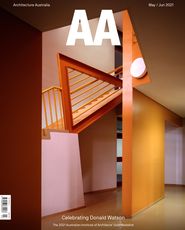
Project
Published online: 24 May 2021
Words:
Giorgio Marfella
Images:
Peter Bennetts,
Willem-Dirk du Toit
Issue
Architecture Australia, May 2021





